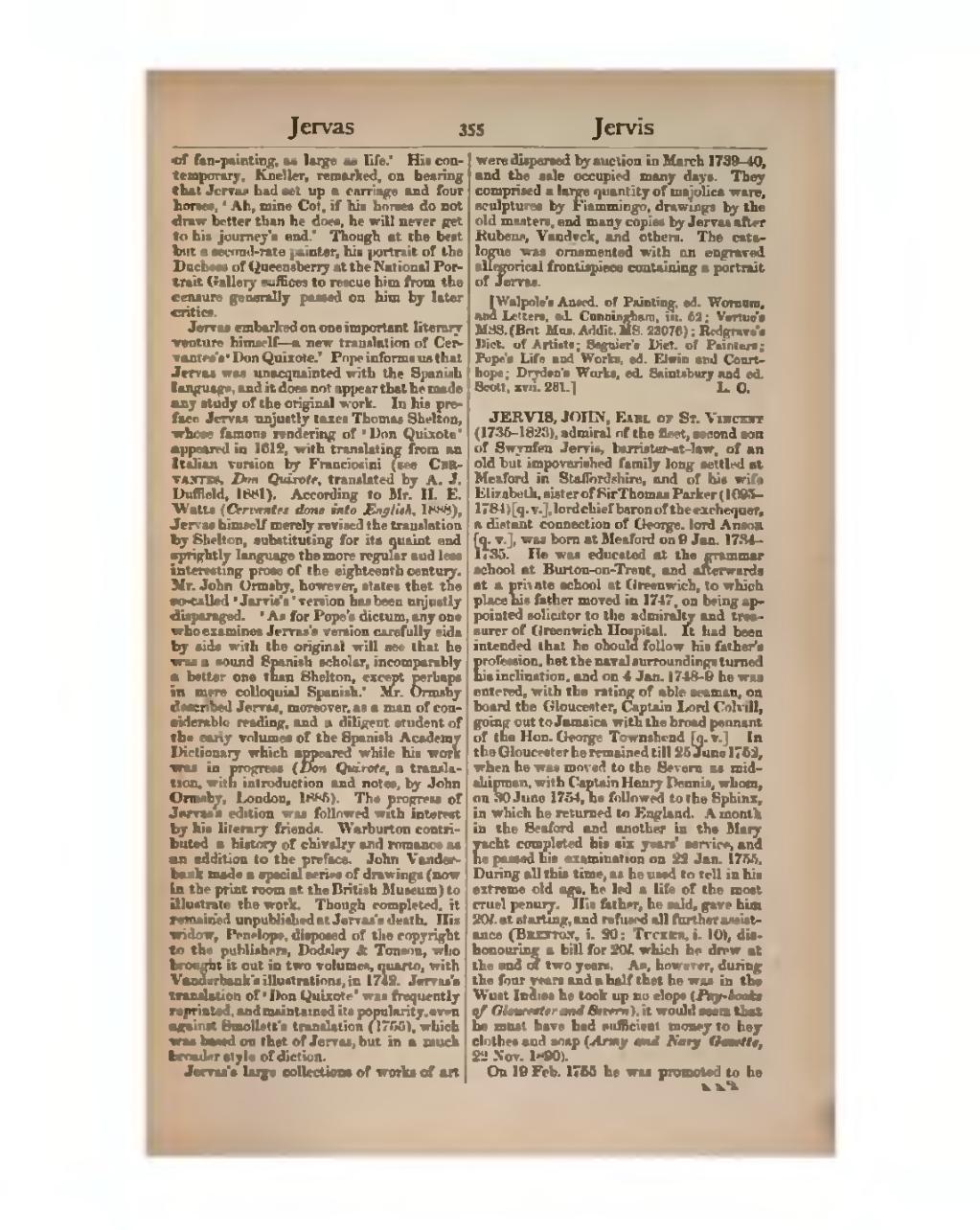of fan-painting, as large as life.’ His contemporary, Kneller, remarked, on hearing that Jervas had set up a carriage and four horses, ‘Ah, mine Cot, if his horses do not draw better than he does, he will never get to his journey's end.’ Though at the best but a second-rate painter, his portrait of the Duchess of Queensberry at the National Portrait Gallery suffices to rescue him from the censure generally passed on him by later critics.
Jervas embarked on one important literary venture himself—a new translation of Cervantes's ‘Don Quixote.’ Pope informs us that Jervas was unacquainted with the Spanish language, and it does not appear that he made any study of the original work. In his preface Jervas unjustly taxes Thomas Shelton, whose famous rendering of ‘Don Quixote’ appeared in 1612, with translating from an Italian version by Franciosini (see Cervantes, Don Quixote, translated by A. J. Duffield, 1881). According to Mr. H. E. Watts (Cervantes done into English, 1888), Jervas himself merely revised the translation by Shelton, substituting for its quaint and sprightly language the more regular and less interesting prose of the eighteenth century. Mr. John Ormsby, however, states that the so-called ‘Jarvis's’ version has been unjustly disparaged. ‘As for Pope's dictum, any one who examines Jervas's version carefully side by side with the original will see that he was a sound Spanish scholar, incomparably a better one than Shelton, except perhaps in mere colloquial Spanish.’ Mr. Ormsby described Jervas, moreover, as a man of considerable reading, and a diligent student of the early volumes of the Spanish Academy Dictionary which appeared while his work was in progress (Don Quixote, a translation, with introduction and notes, by John Ormsby, London, 1885). The progress of Jervas's edition was followed with interest by his literary friends. Warburton contributed a history of chivalry and romance as an addition to the preface. John Vanderbank made a special series of drawings (now in the print room at the British Museum) to illustrate the work. Though completed, it remained unpublished at Jervas's death. His widow, Penelope, disposed of the copyright to the publishers, Dodsley & Tonson, who brought it out in two volumes, quarto, with Vanderbank's illustrations, in 1742. Jervas's translation of ‘Don Quixote’ was frequently reprinted, and maintained its popularity, even against Smollett's translation (1755), which was based on that of Jervas, but in a much broader style of diction.
Jervas's large collections of works of art were dispersed by auction in March 1739–40, and the sale occupied many days. They comprised a large quantity of majolica ware, sculptures by Fiammingo, drawings by the old masters, and many copies by Jervas after Rubens, Vandyck, and others. The catalogue was ornamented with an engraved allegorical frontispiece containing a portrait of Jervas.
[Walpole's Anecd. of Painting, ed. Wornum, and Letters, ed. Cunningham, iii. 52; Vertue's MSS. (Brit. Mus. Addit. MS. 23076); Redgrave's Dict. of Artists; Seguier's Dict. of Painters; Pope's Life and Works, ed. Elwin and Courthope; Dryden's Works, ed. Saintsbury and ed. Scott, xvii. 281.]
JERVIS, JOHN, Earl of St. Vincent (1735–1823), admiral of the fleet, second son of Swynfen Jervis, barrister-at-law, of an old but impoverished family long settled at Meaford in Staffordshire, and of his wife Elizabeth, sister of Sir Thomas Parker (1695–1784) [q. v.], lord chief baron of the exchequer, a distant connection of George, lord Anson [q. v.], was born at Meaford on 9 Jan. 1734–1735. He was educated at the grammar school at Burton-on-Trent, and afterwards at a private school at Greenwich, to which place his father moved in 1747, on being appointed solicitor to the admiralty and treasurer of Greenwich Hospital. It had been intended that he should follow his father's profession, but the naval surroundings turned his inclination, and on 4 Jan. 1748–9 he was entered, with the rating of able seaman, on board the Gloucester, Captain Lord Colvill, going out to Jamaica with the broad pennant of the Hon. George Townshend [q. v.] In the Gloucester he remained till 25 June 1752, when he was moved to the Severn as midshipman, with Captain Henry Dennis, whom, on 30 June 1754, he followed to the Sphinx, in which he returned to England. A month in the Seaford and another in the Mary yacht completed his six years' service, and he passed his examination on 22 Jan. 1755. During all this time, as he used to tell in his extreme old age, he led a life of the most cruel penury. His father, he said, gave him 20l. at starting, and refused all further assistance (Brenton, i. 20; Tucker, i. 10), dishonouring a bill for 20l. which he drew at the end of two years. As, however, during the four years and a half that he was in the West Indies he took up no slops (Pay-books of Gloucester and Severn), it would seem that he must have had sufficient money to buy clothes and soap (Army and Navy Gazette, 22 Nov. 1890).
On 19 Feb. 1755 he was promoted to be
